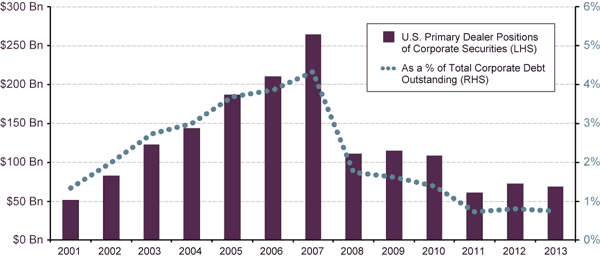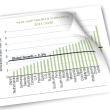June 26 2013
The recent bond market collapse is reminiscent of the Great Crash of 1994. Further pressure on the economy due to rising interest rates could cause the Fed to revisit its timetable for QE.
by Scott Minerd, CIO, Guggenheim Partners LLC
The severe dislocation in fixed income markets is the result of investors’ surprise over the faster-than-expected pace at which the Federal Reserve indicated it plans to taper and eventually end quantitative easing (QE). There are parallels between this event and the bond market crash of 1994 when then-U.S. Federal Reserve Chairman Alan Greenspan increased the federal funds rate by 25 basis points. In the subsequent bond-market rout – the worst since the Great Depression – investors immediately began re-pricing bonds to where they assumed rates would be at the end of the tightening cycle, rather than waiting for interest rates to incrementally move to their new levels. Long-term rates doubled over the next six months and liquidity significantly dried up in the bond market.
When looking closely at the latest projections by the Federal Reserve, their outlook on the unemployment rate by the end of the year suggests that they believe economic activity will accelerate as we head into the summer. I do not subscribe to this view, as we are already seeing pressure on housing and the broader economy from higher interest rates, and the recent spike in yields’ negative impact is likely to continue to show up in the economic data over the summer. Adding all this up, there remains a strong possibility that the Fed will shift the tone of its guidance from QE tapering back to QE expansion or extension before the end of 2013.
Chart of the Week
Liquidity Deterioration in the U.S. Corporate Bond Market
As a result of increased banking regulations, U.S. primary dealers’ positions of corporate securities, including commercial paper, investment grade, and high-yield corporate bonds, have declined substantially from the peak of $260 billion in 2007 to the current level of $68 billion. This reduction in bond inventories could prove to have a negative impact on market liquidity. Investors may have difficulty unwinding their positions amid rising interest rates, as dealers shrink their corporate bond holdings, pushing bond yields higher.
U.S. PRIMARY DEALER POSITIONS OF CORPORATE SECURITIES*

Source: Federal Reserve Bank of New York, Bloomberg, SIFMA, Guggenheim Investments. *Note: Corporate securities include commercial paper, investment grade, and high-yield corporate bonds. Data for 2013 as of 1Q2013.
Economic Data Releases
GDP Revised Down Sharply, Housing Market Continues to Strengthen
- First quarter GDP was revised down to 1.8% annualized growth, led by a downward revision in consumer spending from 3.4% to 2.6%.
- New home sales continued to accelerate in May to an annualized pace of 476,000 homes, the highest since July 2008.
- Existing home sales jumped 4.2% from April to May, reaching an annualized pace of 5.2 million, the best since November 2009.
- The S&P/Case-Shiller 20-city home price index showed an annual increase of 12.1% in April, the highest level since March 2006.
- Mortgage applications fell 3.0% for the week ended June 21st, the sixth decrease in the last seven weeks.
- U.S. durable goods orders expanded 3.6% in May, better than forecast. Orders excluding transportation were up 0.7% and non-defense capital goods orders excluding aircraft rose for a third straight month.
- The Conference Board consumer confidence index surged to 81.4 in June, the best since January 2008.
- Initial jobless claims rose 18,000 to 354,000 for the week ended June 15th.
- Regional Fed indices were generally positive, with the Philadelphia, Richmond, and Dallas indices all rising more than expected.
- The leading indicator index increased just 0.1% in May, driven by the three financial indicators.
European Confidence Up, Chinese Manufacturing Activity Worsens
- Consumer confidence in the euro zone improved for a seventh straight month, rising to a 22-month high of -18.8 during June.
- France’s manufacturing and services PMIs improved more than expected in June, while Germany’s manufacturing unexpectedly fell, and the euro zone composite PMI rose for a third consecutive month to 48.9.
- The June IFO survey of Germany’s business climate increased for a second consecutive month to 105.9.
- Consumer confidence in Italy surged from 86.4 to 95.7 in June, the highest level in more than one year.
- Retail sales in Italy fell for an eighth consecutive month in April, down 0.1%.
- China’s HSBC flash manufacturing PMI disappointed in the June reading, showing an accelerated contraction of manufacturing activity at 48.3.
- Japanese exports jumped 10.1% in May from a year earlier, the best annual gain since December 2010.
This article is distributed for informational purposes only and should not be considered as investing advice or a recommendation of any particular security, strategy or investment product. This article contains opinions of the author but not necessarily those of Guggenheim Partners or its subsidiaries. The author’s opinions are subject to change without notice. Forward looking statements, estimates, and certain information contained herein are based upon proprietary and non-proprietary research and other sources. Information contained herein has been obtained from sources believed to be reliable, but are not assured as to accuracy. No part of this article may be reproduced in any form, or referred to in any other publication, without express written permission of Guggenheim Partners, LLC. ©2013, Guggenheim Partners. Past performance is not indicative of future results. There is neither representation nor warranty as to the current accuracy of, nor liability for, decisions based on such information. Past performance is not indicative of future results. There is neither representation nor warranty as to the current accuracy of, nor liability for, decisions based on such information.











